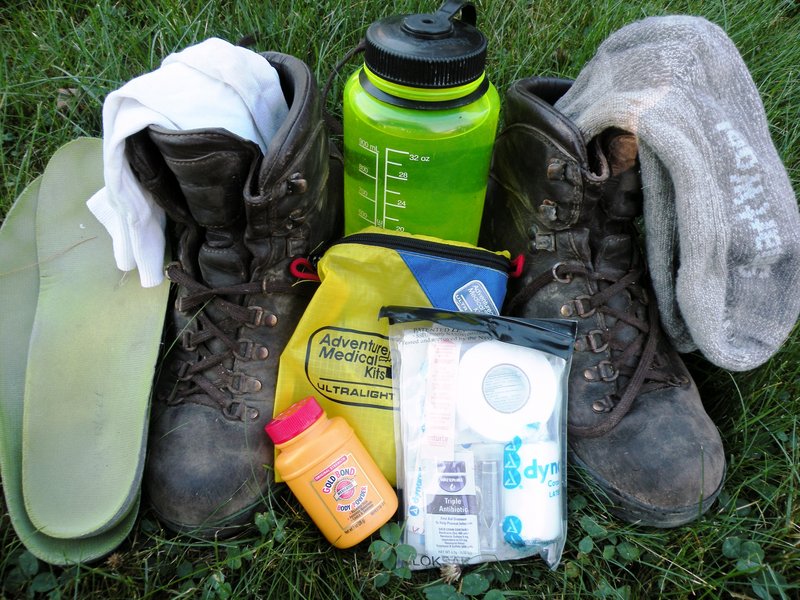It’s a fact that healthy feet are essential for happy hiking. Nothing will ruin a good hiking trip faster than ill-fitting boots, poor quality socks and a few painful blisters. Many of us have had to find this out the hard way, sometimes many miles, perhaps even days, from the nearest road. With no choice but to doctor up the dogs, we hobble onward with a grimace. But with a modicum of planning and care, it doesn’t have to be that way.
“With the right shoe, the right sock and the right footbed, you should be good to go for a successful hike,” said Lisa Smith, store supervisor at Eastern Mountain Sports in Portland and an expert in hiking boots and foot care. Smith walked me through the process EMS follows to ensure happy trail feet.
The first step is to get the customer’s feet into a Brannock device, that stainless-steel contraption we’ve all seen in shoe stores that measures shoe size. Many people think they know their size, but very often they don’t, and doing this eliminates the guess work.
The next step is to query the buyer about foot issues, such as the presence of bunions and whether they walk pronate (on the outside of the feet) or underpronate (inside of feet).
Finally, it’s time to select a boot that’s right for the intended type of hiking, which could be anything from day hiking with a light pack to an extended backpack trip toting a heavy pack.
Boots are tried on with socks similar to those that will be worn on the trail. For this step EMS keeps a selection of “try-on” socks handy. Customers can also purchase socks from the rack or bring their own from home.
Smith completely dismisses cotton socks for hiking, recommending synthetic or wool because they wick well, don’t itch and are stretchy. The quality of socks has advanced so much that hikers may not even need the traditional thin liner socks.
Another item that should go into the boot along with socks and feet are footbeds. Not everyone wants to spend the extra money on footbeds, but they really do provide better arch support and help prolong the life of the shoe.
With shoes on and laced up, it’s time to walk up and down on the special ramp designed to test the fit and feel of the boots, noting if the heel slips or the toes push too far forward.
“If it doesn’t feel good in the store, it won’t feel good on the trail,” Smith said.
Once out on the trail, the best way to avoid blisters is to keep your feet dry. And that good wicking pair of socks you just bought is your first and best line of defense. Take time to rest your feet and air them out at least once during the day. And carry a couple extra pairs so you can always wear a dry pair, have a dry pair in your pack and keep a third pair drying outside your pack.
“Moisture and friction equals blisters,” Smith said. “So you want to try to minimize both with good fitting boots and quality wicking socks.”
A sprinkle of medicated foot powder on your feet and into your socks not only feels good but also works to keep feet dry and reduce nasty foot odor.
Despite your best efforts, should you get a hot spot or worse, a blister, stop and treat it immediately. Apply an alcohol wipe, then cover with a sealant patch and you should be on your way. If the blister is particularly bad, you may have to resort to a patch of Moleskin, a dab of antibiotic ointment and some athletic tape.
“Prevention is definitely best,” cautioned Smith. “Because once you get a blister then it’s up to your body to heal it, and that takes time.”
Drinking plenty of water on your hike is always a good thing for a variety of reasons, including flushing out the toxins like lactic acid that build up in your system. That makes for happier muscles and happier feet.
Away from the trail, Smith recommends getting regular foot massages, either from a professional or a partner or spouse.
“It feels great and it really makes a difference,” she said.
Carey Kish of Bowdoin is a freelance writer and avid hiker. Send comments and hike suggestions to:
MaineOutdoors@aol.com
Send questions/comments to the editors.



Success. Please wait for the page to reload. If the page does not reload within 5 seconds, please refresh the page.
Enter your email and password to access comments.
Hi, to comment on stories you must . This profile is in addition to your subscription and website login.
Already have a commenting profile? .
Invalid username/password.
Please check your email to confirm and complete your registration.
Only subscribers are eligible to post comments. Please subscribe or login first for digital access. Here’s why.
Use the form below to reset your password. When you've submitted your account email, we will send an email with a reset code.